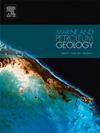Compaction and pore preservation mechanisms of deep-buried sandstone reservoirs under the influence of sedimentary grain size characteristics: Insights from DEM simulations
IF 3.7
2区 地球科学
Q1 GEOSCIENCES, MULTIDISCIPLINARY
引用次数: 0
Abstract
The compaction and grain crushing (GC) of deep-buried sandstone reservoirs play a crucial role in the evolution of reservoir quality. Significant differences exist in the compaction behavior and pore preservation of reservoirs with varying sedimentary grain size characteristics. However, there is a lack of quantitative assessments and mechanistic studies of these processes. This study utilizes the Discrete Element Method (DEM) to simulate two groups of samples with different grain size distributions (GSD) to explore the processes of compaction and pore preservation. Group A samples exhibit a unimodal Gaussian GSD, with the median grain size (Md) gradually increasing, while Group B samples share the same Md but differ in GSD type. The results indicate that with increasing stress, the samples undergo three compaction stages: grain rearrangement (S1), intense GC and rearrangement (S2), and weak GC and rearrangement (S3). In S1, grains rearrange with minimal sliding and no GC, resulting in a low porosity loss rate (Δϕ/Δσ). In S2, GC intensifies, with fragments sliding and filling the pores between grains, leading to a significant increase in Δϕ/Δσ. In S3, a high coordination number reduces GC, and small pores restrict the movement of fragments, resulting in a decrease in Δϕ/Δσ. Md has no effect on Δϕ/Δσ in S1. However, samples with smaller Md experience weaker GC and have smaller pore size, making it more difficult for fragments to fill the pores during S2. In S3, samples with larger Md have higher coordination numbers, providing stronger buffering against GC and resulting in lower Δϕ/Δσ. Additionally, GSD does not affect Δϕ/Δσ during S1. In S2, sample with a coarse-skewed bimodal Gaussian GSD exhibited the weaker GC, smaller difference between pore size and fragment size, resulting in a relatively low Δϕ/Δσ. Therefore, under deep burial conditions, sandstone with small grain size and coarse-skewed bimodal GSD demonstrates strong resistance to compaction and effective pore preservation.
求助全文
约1分钟内获得全文
求助全文
来源期刊

Marine and Petroleum Geology
地学-地球科学综合
CiteScore
8.80
自引率
14.30%
发文量
475
审稿时长
63 days
期刊介绍:
Marine and Petroleum Geology is the pre-eminent international forum for the exchange of multidisciplinary concepts, interpretations and techniques for all concerned with marine and petroleum geology in industry, government and academia. Rapid bimonthly publication allows early communications of papers or short communications to the geoscience community.
Marine and Petroleum Geology is essential reading for geologists, geophysicists and explorationists in industry, government and academia working in the following areas: marine geology; basin analysis and evaluation; organic geochemistry; reserve/resource estimation; seismic stratigraphy; thermal models of basic evolution; sedimentary geology; continental margins; geophysical interpretation; structural geology/tectonics; formation evaluation techniques; well logging.
 求助内容:
求助内容: 应助结果提醒方式:
应助结果提醒方式:


